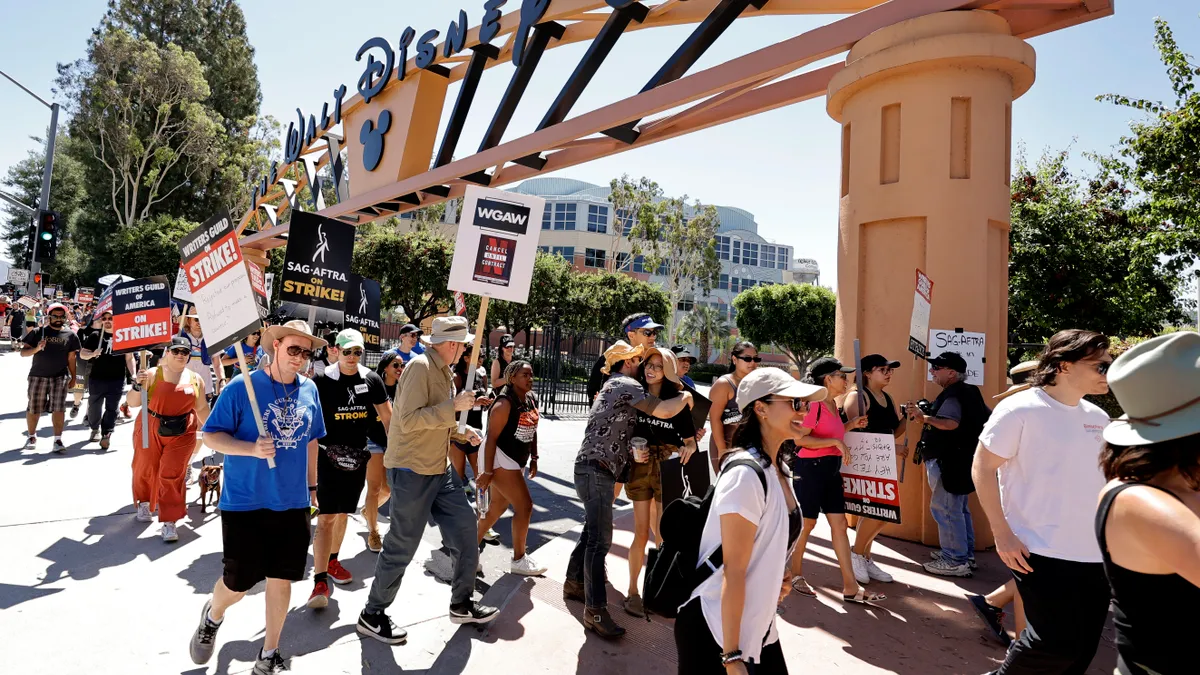Dual writer and actor strikes will not only shut down Hollywood productions and delay the release of new TV and film content: The labor actions are also likely to have a trickle down effect on an advertising industry that is already struggling to adapt to new business models and increased competition, according to industry experts.
The actors' union SAG–AFTRA went on strike on July 14, joining the Writers Guild of America (WGA), which has been on the picket line since May 2. Both unions have an ongoing labor dispute with the Alliance of Motion Picture and Television Producers (AMPTP), generally over ways that streaming has affected residuals but also how AI will be used by Hollywood moving forward. Advertising has served as an important foundation for the industry, especially as streaming services like Netflix, Max and others increasingly look to free ad-supported subscription tiers to finance their businesses.
"While video advertising and subscription revenues are expected to grow by double digits this year and next, the dual strikes could threaten that economy, especially if the standoffs run deep into the fall season," said Insider Intelligence principal analyst Paul Verna, in emailed comments.
High alert
The shutdown comes as the linear TV industry prepares for the fall TV season, which features new entertainment programming and typically delivers the highest levels of ad revenues. The industry is on "high alert" as a lack of new content could put a dent in those revenues, according to Darrick Li, vice president of sales for North America media owners at media planning company Guideline.
"There is a ripple effect where over time there is less content for media owners to deliver audiences, advertisers that see less impact from their advertising investments, and less capital for media companies to put back into new production, technologies, and development, creating a vicious cycle where nobody wins," Li said in emailed comments.
To counter the possibility of lower viewership and lower revenue, broadcasters could focus on unscripted television, particularly live sports, as was the case during the 2007-08 writers strike. While live TV could prove to be a sustainable channel throughout the strikes, the proliferation of streaming TV platforms in the last few years make this a significantly different landscape since the last Hollywood labor action. The dual strike could widen the divide between linear TV and connected TV (CTV), said Britt Augenfeld, vice president of advanced TV and video at search intelligence platform Captify.
"Connected TV loyalists will still tune in to their favorite shows and watch when and where they watch in the moment — content aside. Network television unfortunately doesn’t have the same luxury," Augenfeld said in emailed comments. "Overall, studios are positioned to suffer the most at this moment, as a lack of content could result in a loss of thousands of subscribers, millions in potential advertising dollars and an over reliance on re-runs and reality shows, which consumers have plenty of access to."
Delayed commitments
While the strikes could alter the CTV landscape, they are unlikely to upend it. Many streaming services are loaded with content that customers are already unable to exhaust, to say nothing of content they have hoarded for a rainy day. The lack of new content could slow subscriber growth that was already slowing as streaming services reached maturity, but the services still benefit from ongoing trends that the strikes will not halt.
"I don't think folks are getting any vasectomy reversal when it comes to cord cutting," said Hunter Terry, vice president of solutions consulting and CTV commercial lead at data solutions company Lotame, in emailed comments. "The viewers are here to stay, they just need to find their next Truman show now that their favorites may be coming to an end."
As the strikes continue, advertisers face yet another wait-and-see scenario as uncertainty surrounds how a closed content spigot will impact ad spend.
"While the Writer’s Strike hasn't yet made a notable dent in advertising plans, the addition of the much larger and higher profile SAG-AFTRA membership to the collective cause may cause advertisers to further delay upfront commitments and add another layer of pressure on the studios and streamers to negotiate with more speed and willingness," said Erin Firneno, vice president of business intelligence at Advertiser Perceptions, in emailed comments.















